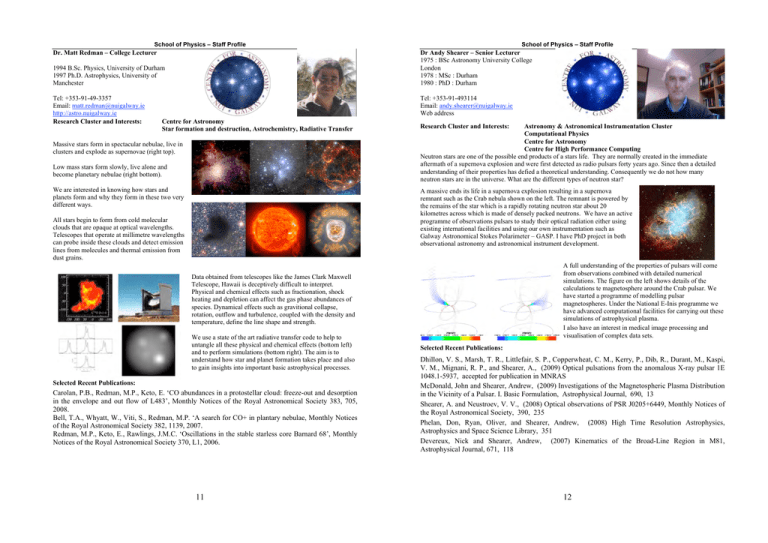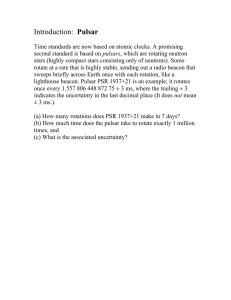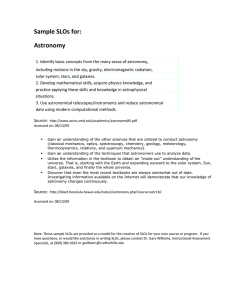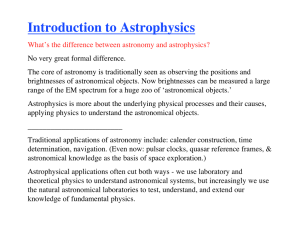Dr. Matt Redman – College Lecturer
advertisement

School of Physics – Staff Profile Dr. Matt Redman – College Lecturer 1994 B.Sc. Physics, University of Durham 1997 Ph.D. Astrophysics, University of Manchester Tel: +353-91-49-3357 Email: matt.redman@nuigalway.ie http://astro.nuigalway.ie Research Cluster and Interests: School of Physics – Staff Profile Dr Andy Shearer – Senior Lecturer 1975 : BSc Astronomy University College London 1978 : MSc : Durham 1980 : PhD : Durham Tel: +353-91-493114 Email: andy.shearer@nuigalway.ie Web address Centre for Astronomy Star formation and destruction, Astrochemistry, Radiative Transfer Massive stars form in spectacular nebulae, live in clusters and explode as supernovae (right top). Low mass stars form slowly, live alone and become planetary nebulae (right bottom). We are interested in knowing how stars and planets form and why they form in these two very different ways. Research Cluster and Interests: Astronomy & Astronomical Instrumentation Cluster Computational Physics Centre for Astronomy Centre for High Performance Computing Neutron stars are one of the possible end products of a stars life. They are normally created in the immediate aftermath of a supernova explosion and were first detected as radio pulsars forty years ago. Since then a detailed understanding of their properties has defied a theoretical understanding. Consequently we do not how many neutron stars are in the universe. What are the different types of neutron star? A massive ends its life in a supernova explosion resulting in a supernova remnant such as the Crab nebula shown on the left. The remnant is powered by the remains of the star which is a rapidly rotating neutron star about 20 kilometres across which is made of densely packed neutrons. We have an active programme of observations pulsars to study their optical radiation either using existing international facilities and using our own instrumentation such as Galway Astronomical Stokes Polarimeter – GASP. I have PhD project in both observational astronomy and astronomical instrument development. All stars begin to form from cold molecular clouds that are opaque at optical wavelengths. Telescopes that operate at millimetre wavelengths can probe inside these clouds and detect emission lines from molecules and thermal emission from dust grains. A full understanding of the properties of pulsars will come from observations combined with detailed numerical simulations. The figure on the left shows details of the calculations te magnetosphere around the Crab pulsar. We have started a programme of modelling pulsar magnetospheres. Under the National E-Inis programme we have advanced computational facilities for carrying out these simulations of astrophysical plasma. I also have an interest in medical image processing and visualisation of complex data sets. Data obtained from telescopes like the James Clark Maxwell Telescope, Hawaii is deceptively difficult to interpret. Physical and chemical effects such as fractionation, shock heating and depletion can affect the gas phase abundances of species. Dynamical effects such as gravitional collapse, rotation, outflow and turbulence, coupled with the density and temperature, define the line shape and strength. We use a state of the art radiative transfer code to help to untangle all these physical and chemical effects (bottom left) and to perform simulations (bottom right). The aim is to understand how star and planet formation takes place and also to gain insights into important basic astrophysical processes. Selected Recent Publications: Carolan, P.B., Redman, M.P., Keto, E. ‘CO abundances in a protostellar cloud: freeze-out and desorption in the envelope and out flow of L483’, Monthly Notices of the Royal Astronomical Society 383, 705, 2008. Bell, T.A., Whyatt, W., Viti, S., Redman, M.P. ‘A search for CO+ in plantary nebulae, Monthly Notices of the Royal Astronomical Society 382, 1139, 2007. Redman, M.P., Keto, E., Rawlings, J.M.C. ‘Oscillations in the stable starless core Barnard 68’, Monthly Notices of the Royal Astronomical Society 370, L1, 2006. 11 Selected Recent Publications: Dhillon, V. S., Marsh, T. R., Littlefair, S. P., Copperwheat, C. M., Kerry, P., Dib, R., Durant, M., Kaspi, V. M., Mignani, R. P., and Shearer, A., (2009) Optical pulsations from the anomalous X-ray pulsar 1E 1048.1-5937, accepted for publication in MNRAS McDonald, John and Shearer, Andrew, (2009) Investigations of the Magnetospheric Plasma Distribution in the Vicinity of a Pulsar. I. Basic Formulation, Astrophysical Journal, 690, 13 Shearer, A. and Neustroev, V. V., (2008) Optical observations of PSR J0205+6449, Monthly Notices of the Royal Astronomical Society, 390, 235 Phelan, Don, Ryan, Oliver, and Shearer, Andrew, (2008) High Time Resolution Astrophysics, Astrophysics and Space Science Library, 351 Devereux, Nick and Shearer, Andrew, (2007) Kinematics of the Broad-Line Region in M81, Astrophysical Journal, 671, 118 12





